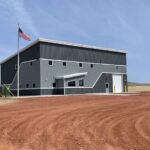A test plant that will be part of research into producing cleaner-burning coal for power plants is set to begin operation next year in Wyoming, with the company behind the project saying global demand for coal makes the project viable even as the U.S. reduces its reliance on coal for electricity production.
Clean Coal Technologies Inc. (CCTI) is building the test facility in Tulsa, Oklahoma, and plans to move it to northeast Wyoming near the end of January 2018. Other companies have been using coal-drying techniques for several years, but the New York-based company has been developing what it calls “the world’s first commercially viable and scalable coal dehydration technology” that is designed to upgrade the Btu content of lower-ranking coal “through the extraction of volatile material in liquid form,” ultimately producing a “cleaner burning, dry coal.”
The facility would dry Powder River Basin (PRB) coal, making it burn hotter with lower emissions, and increasing its value on the global market, according to CCTI. The company did not immediately respond to requests from POWER for comment on the cost of building and transporting the plant, although the company in June 2017 said a group of investors was seeking $80 million to build a facility in the PRB.
The company’s CEO, Robin Eves, in a December 14 conference call said the test facility at the AES Shady Point coal-fired plant near Tulsa is being “mothballed” for its move to the site of the abandoned Two Elk power plant project near Wright, Wyoming. Eves said a commercial facility capable of processing 30 tons of coal per hour also will be located at the site.
Two Elk is located in the heart of the PRB. At present, the site—once proposed for a 300-MW power plant, and for use in carbon capture research—is little more than concrete pads.
CCTI will seek permits from the Wyoming Department of Environmental Quality for commercial operation of its plant. Eves said CCTI wants to have the test plant online by the end of the first quarter of 2018, have all permitting in place within six months, and begin commercial operation by year-end 2019.
Eves during the call said, “The [test] plant has been upgraded to operate at a much higher level than before.” He said his company’s technology “has the capability of acting as a coal refinery, which has significant value around the world.”
CCTI in October 2017 signed a memorandum of understanding with the School of Energy Resources at the University of Wyoming, in part to take advantage of the school’s expertise with coal technologies. Eves at the time said the school and its Carbon Engineering Initiative “is sharply focused on advantaging and maximizing the potential of Wyoming mineral resources especially coal, both domestically and overseas, and our technology fits very well in Wyoming actualizing their strategies. With one of CCTI’s top priorities being to beneficiate Powder River Basin coal, the synergies achievable from joining hands with the School of Energy Resources are compelling for us.”
The school in a statement in November said it thought the CCTI project was a good fit for the university’s own studies of coal refining.
Eves said he wanted the university’s help to “perfect the design and engineering of the first commercial module,” and “start developing the second and third generations of the technology.” He also said the partnership has given “huge validity to our technology” and led to partnerships with universities in Australia.
CCTI’s process is designed to reduce moisture in coal and still leave it stable and safe, while also increasing its energy output above that of untreated coal. Dried coal can self-combust when it reabsorbs moisture; solving that problem has been key to making the technology commercially viable. CCTI says its refined product is safe and produces fewer emissions, including carbon dioxide (CO2), when burned.
Eves said the company wants to take advantage of continued strong demand for coal in the global market. “It’s critical to sustain and develop coal reserves around the world,” he said. “Now the coal industry has accepted there’s a technology that can [treat] and upgrade coal.”
A recent report by the International Energy Agency said global coal demand fell in 2016 for a second straight year, but that coal use continues to rise in India and Asia. Eves in the conference call said the company is negotiating with potential customers for its refined coal in Australia, India, and Indonesia, although the company did not immediately respond to POWER’s request for more specifics on those customers, or on investors in the project.
One investor had previously been reported as Wyoming New Power, whose founding member, Patrick Imeson, is managing director of Denver, Colorado-based Black Diamond Holdings, which has stakes both in Wyoming New Power and CCTI. Wyoming New Power filed as a business in the state earlier this year. Online magazine WyoFile in November reported that Imeson on November 6, 2017, petitioned Campbell County commissioners for $100 million in industrial development bonds to help build the facility. Imeson, however, withdrew that request just days later, ahead of a scheduled November 21 vote on the bonds.
The Two Elk site in Wyoming has a checkered history. It was proposed in 1996 as the location for a power plant that would burn waste coal. Its developer, Michael Ruffatto, also talked about using the site for research into carbon capture.
However, the project sustained numerous delays, and its use of state and federal funds was questioned. Ruffatto, now 71, in 2016 pleaded guilty to defrauding the federal government of millions of dollars, taking money intended for the project for his personal use, and fabricating invoices. His sentencing has been delayed several times as he attempts restitution; the next hearing in the case is set for January 31, 2018. He could be sentenced to as much as three years in prison.
—Darrell Proctor is a POWER associate editor (@DarrellProctor1, @POWERmagazine)










